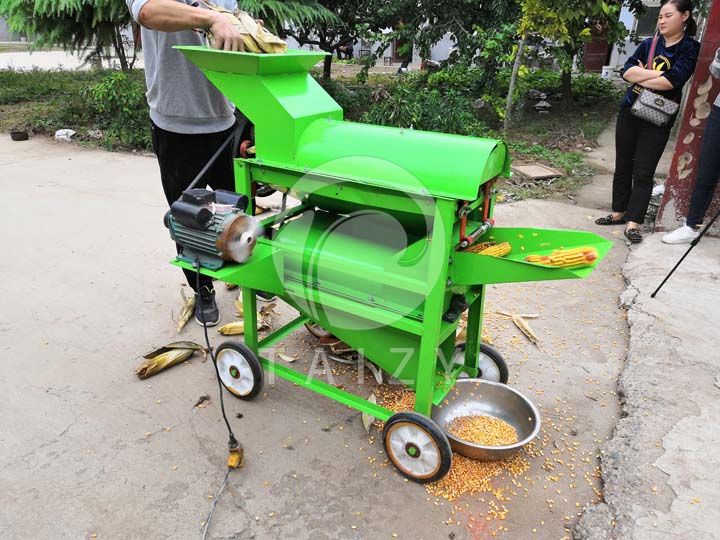The corn thresher is a kind of machine used on the field. For agricultural machinery users, if they have a certain knowledge of maintenance, they can not only achieve safe production during the operation process but also improve operational efficiency and operation quality. Thereby increasing their income and reducing their production costs. And greatly extend the service life of the machine, which is of great significance.
This article is mainly about the repair and maintenance of corn threshers and proposes corresponding solutions for the problems that arise.
Safe use and maintenance of corn thresher
(1) Check the tension of the triangle drive belt, and readjust if it is too loose or too tight.
(2) Check the tension of the transmission chain and adjust it to within the specified value according to the requirements of the instruction manual.
(3) Check whether the belt pulley and other transmission systems are in normal condition and adjust to the best condition.
(4) Before starting work, confirm whether the direction of rotation is correct, that is, start the corn thresher and observe it for 5-10 seconds. If there is no abnormal sound or vibration, the threshing operation can be continued.
(5) The feeding of materials (corn) should not be interrupted or intermittent during operation and should be fed continuously and evenly. Moreover, the amount of feeding should be moderate, not to increase or decrease, otherwise, the quality and efficiency of corn threshing may be affected, and the machine may be blocked or damaged in severe cases. It is especially emphasized that once a blockage is found during operation, it must be shut down immediately, and the standby device can be cleaned up when the standby device is not running at all.
(6) When working in deep winter, pay attention to the degree of dryness and wetness of corn. The dryness and wetness of corn are directly related to the quality of threshing. Corn has less moisture, good threshing effect, clean threshing, and fast threshing, and users are also satisfied. When everything is the opposite, adjust the machine at any time.
(7) In order to ensure that the thresher can always operate safely, the bolts and screws that fasten the drum and the bearing seat must be checked anytime and anywhere. Otherwise, tighten it in time. If the machine is found to be abnormal during operation, it should be stopped before adjustment. The roller and bearing seat bolts always bear dynamic load during machine operation, and they will loosen after long-term operation. If they are not inspected and corrected in time, serious consequences will result.
(8) During work, no maintenance of any form or content shall be carried out on the machine, and all actions must be carried out after shutdown. It is strictly forbidden to troubleshoot under working conditions. Don’t use sticks or utensils to feed people during the working process, and don’t force people to feed people when the feeding is blocked. You must wait until the machine is naturally emptied before re-feeding. If it cannot be emptied naturally, the machine should be completely shut down before cleaning.
(9) In order to prolong the service life of the machine and obtain better economic benefits, all wear parts must be timely and accurately lubricated and maintained.

corn-peeler-and-sheller-1 
corn-peeler-and-sheller-2
Common faults and maintenance
(1) The threshing is not clean. Excessive feeding amount, uneven feeding, the threshing gap between the pattern bar and the concave plate, low drum speed, and too wet grain will cause unclean threshing. The maintenance methods at this time are as follows: reduce the amount of feed and feed evenly; regulate the threshing gap, and the severely worn parts should be replaced in time; the belt pulley of the power machine and the belt pulley of the thresher should be matched reasonably. Tighten the pulley to tighten the belt; dry the corn before threshing.
(2 )The cleanliness of corn kernels is poor. When this happens, check the tightness of the fan drive belt and tighten the pulley to an appropriate level. If the fixing screw of the fan pulley is loose, tighten the screw. Finally, we should start with the investigation of the feeding amount, and by reducing the feeding amount or adjusting the feeding amount gap correctly, the cleanliness of the corn kernels can be ensured.
(3) Too many broken corn kernels. The threshing gap is too small, the drum speed is too high, and the feed is uneven or the grain is too dry or too wet. When this happens, check whether the threshing gap is correct. In addition, check whether the matching of the drum pulley and the power pulley is reasonable and accurate. If something is wrong, it should be adjusted or replaced. In addition, you should try to ensure that the feeding is even, dry grains are fed more, and the humidity is high and less fed.
(4) The corn cob contains the ear of corn. When this fault occurs, check whether the thresher has the following problems: not working under full load; uneven feeding; thresher speed does not meet the requirements; improper adjustment of the cob outlet plate; corn ears overhead in the hopper; stones or Debris clogged the short concave plate; the corn ear has too much moisture; the drum is not adjusted properly.
(5) The pelletizer stops rotating. If the V-belt is too loose, the large and small bevel gears are separated, the blade and the shaft are separated, which will cause the granulator to stop and malfunction. The troubleshooting method is to tighten and replace the V-belt to clean up the blockage according to the cause of the failure; adjust the pitch of the bevel gear; and re-weld the blade and the shaft.